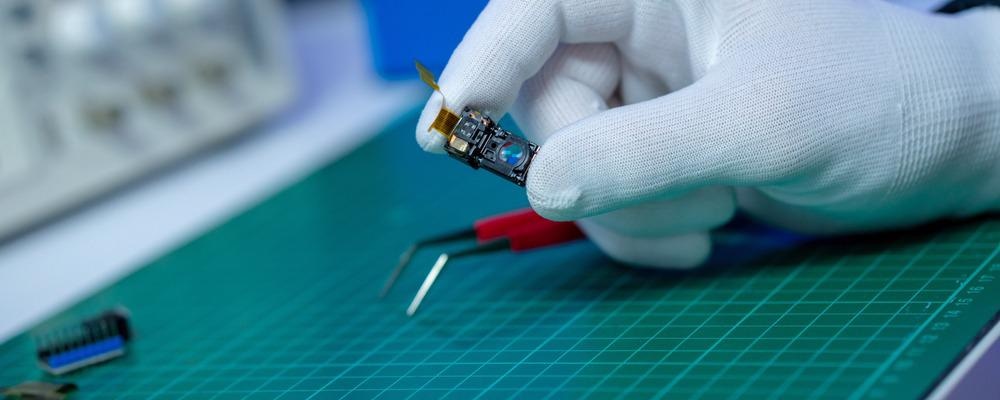Researchers have demonstrated how advanced 3D printing can be used to produce high-performing, miniature lenses for micro-optic imaging applications. These lenses, 3D-printed to sizes of only a few microns, effectively correct color distortion during imaging. They could herald a new generation of microscopic, lightweight cameras and imaging devices for a wide array of applications.

Image Credit: luchschenF/Shutterstock.com
Advanced Additive Manufacturing Technology: Two-Photon Lithography
The research team, based at the University of Stuttgart, Germany, employed an advanced 3D printing method called two-photon lithography. This technique enabled them to combine refractive and diffractive surfaces in one step in an additive manufacturing workflow.
In two-photon lithography, a laser beam is used to solidify the feedstock material. For feedstock, two-photon lithography uses photoresist materials – or light-sensitive liquids. With these materials, polymerization occurs when the surface is exposed to light emitted at a specific wavelength.
Two-photon lithography takes advantage of the optical phenomenon referred to as two-photon absorption. This process is extremely localized, and therefore two-photon lithography can print objects at extremely high resolutions.
The photoresist material polymerizes at a rate of only cubic micrometers in volume. Therefore, two-photon lithography can print structures with complexities, shapes, and features that have been engineered at the micron scale.
For miniature lenses, this capacity enables flawless manufacture that results in far less distorted images.
The researchers also showed that using multiple materials while 3D printing the lenses – with separate steps in a clearly outlined workflow, set out in the study – can result in lenses with better optical performance as well.
Micro-Optics Breakthrough Came from Decade of Work
The researchers behind this breakthrough in micro-optics technology had been working on a solution for better micro-imaging for 10 years.
When the team noticed chromatic aberrations in the images it produced with its existing micro-imaging devices – errors in the way colors in the sample were represented by micro-imaging techniques – the Stuttgart team set out to find a solution.
Chromatic aberrations such as these had already been eliminated from conventional, full-scale imaging devices. This is done by using an achromatic lens in the optical device. Achromatic lenses include both a refractive and diffractive component. By bringing two wavelengths into focus on the same plane, these lenses can minimize the occurrence and effects of chromatic aberration in the final image.
The Stuttgart researchers designed miniature replica models of these achromatic images that could provide instructions for the latest 3D printing technology. Then, they used NanoScribe GmbH’s commercially available two-photon lithography instrument to 3D print the combination lens type.
This method is capable of 3D printing a diffractive lens surface onto a smooth refractive lens in one workflow step.
What are the Benefits of 3D Printing for Micro-Optics?
In recent years, 3D printing has emerged as the primary manufacturing technology for miniature optics. Techniques for 3D printing at the micron scales required by this field have improved dramatically in the last few years, and the benefits of additive manufacturing may now be brought to bear in this advanced manufacturing sector.
3D printing offers micro-optics manufacturers a far greater degree of design freedom. Lenses can be produced to fit perfectly with miniature optics instruments so that they can be designed with fewer form and weight compromises.
Introducing 3D printing to this sector introduces a previously impossible level of local production and shareable technology. Scientists and researchers can reproduce and iterate on the latest technological advances, without having to leave their campuses.
3D printing also means that research and development engineers can continually iterate their designs to ensure optimum performance. Prototypes and new models can come off the same production line as previous models without the cost barriers that this entails in traditional manufacturing.
Applications for 3D-Printed Miniature Lenses
3D-printed, miniature lenses will have numerous applications in the micro-optics industry. They can be directly fabricated onto other surfaces and incorporated into existing advanced 3D printing workflows.
For example, the CCD or CMOS chips in digital cameras could be directly connected to miniature lenses printed on the chip. The lenses can also be printed on the ends of optical fibers, allowing for microscopic medical endoscopes with superb imaging quality.
References and Further Reading
Schmid, Michael, Florian Sterl, Simon Thiele, Alois Herkommer, and Harald Giessen (2021) 3D-Printed Hybrid Refractive/Diffractive Achromat and Apochromat for the Visible Wavelength Range. Optics Letters. https://doi.org/10.1364/OL.423196.
Disclaimer: The views expressed here are those of the author expressed in their private capacity and do not necessarily represent the views of AZoM.com Limited T/A AZoNetwork the owner and operator of this website. This disclaimer forms part of the Terms and conditions of use of this website.